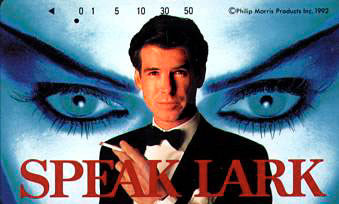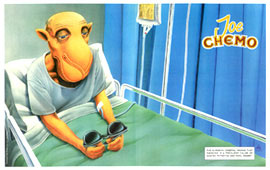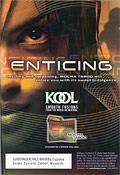The Truth About Tobacco
Text version of our anti-smoking live assembly program
for middle and high schools
Video clips from live talks
(Youth talk clips begin at the 4th clip down.)
Topics covered in the live talk
Quotes from teachers who saw the live program
Recent news coverage of live talks
Introduction to the speaker
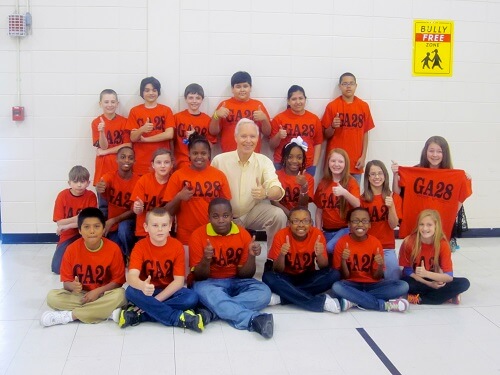
Patrick Reynolds was the first tobacco industry figure to turn his back on the cigarette makers. He’s a grandson of the tobacco company founder R.J. Reynolds, but the family’s cigarette brands, Camel and Winston, killed his father and eldest brother. Since first speaking out in Congress in 1986, Patrick has been a well-respected champion for a tobaccofree society. In hundreds of live talks before universities, middle schools and high schools, and with over 6,000 copies of his educational video purchased by schools and health departments, Mr. Reynolds has reached well over a million youth in school with his powerful talk about the dangers of tobacco.
“In a little over an hour, Reynolds went from being just another anti-tobacco speaker to something special,” commented one local paper. Recent news articles about his appearances illustrate how his appearances can bring the tobaccofree message to the whole community, and build goodwill for sponsors.
A short phone call to a local hospital will plant the idea with its Community Relations Director to sponsor his talk. County health departments and tobaccofree coalitions will often chip in. Print out our Five Minute Plan now and make one call!
See the quotes from teachers who saw him speak live. Mr. Reynolds also offers a highly motivational lecture program for universities.
Patrick Reynolds is devoting his life to furthering the goal of a smokefree society, and to motivating young people to stay tobaccofree.
A text version of his talk for youth follows below. Additional material has been added.
Learn more about Tobaccofree Earth

The Truth About Tobacco
Text of our live anti-smoking
assembly program
for grades 7-12
My father died from smoking
I want to begin today with a little story. My parents were divorced when I was three, and for six long years, I didn’t see my Dad. Now a boy needs his Dad to come to the football game and say, “You played well, son. I’m proud of you you’re my boy!” He needs his Dad’s hugs, encouragement, guidance and love. I didn’t have that, and it was hard for me. A girl needs her Dad, too. Some of you in the audience do not have your biological father living at home with you, and you share the situation I remember. How do you feel about that? Are you angry, or sad, or maybe a little afraid, not having him around as much as you would like? Or a combination of feelings?
Today we’re going to spend some of our time talking about our feelings. How did I feel? At times, I felt angry, sad and afraid without my Dad around.
For six years, I really missed him. When I was nine, I got the idea to write him a letter. It said,‘Dear Dad I want to meet you. Where are you? ‘He was traveling at the time, and amazingly, my little letter was forwarded seven times from city to city. By a miracle, it got into his hands and he sent for me. I remember the day I first got word that he wanted to meet me, and I was jumping up and down with joy.
When the big day came at last, and they showed me into the room where he was, I was saddened to find my Dad lying down, on his back, gasping for breath. He was dying from emphysema, caused by smoking the cigarettes that made our family wealthy.
I only got to see him on five visits after that, and every time, he was increasingly sick and frail and counting the time he had left to live.
My Dad died from smoking I was 15, and that was hard. Later, my aunt and oldest brother would die because they smoked. That’s why I chose to totally turn my back on my family’s former tobacco business and walk away and to do everything in my power to connect with young people and persuade them to stay tobaccofree.
I also did it because doing this work, I have been able to make a difference. It feels wonderful to contribute to the lives of others to be of service.
So those are two reasons I chose to devote my life to the tobaccofree cause. In 1989 I founded Tobaccofree Earth, and I’ll dedicate myself to this work for the rest of my life.
Tobacco Is Extremely Addicting
If I could give you just one message today, it would be this: smoking is extremely addicting. Once you start, you may not be able to stop ever. And the same is true for drugs and alcohol.
I can’t emphasize this enough some of you may not ever be able to stop if you start smoking or chewing tobacco.
How long does it take to get hooked? A September 2000 study showed that one-quarter of 11 to 13-year-olds who smoke as few as two or three cigarettes a day become addicted in just two weeks. And many of the rest got addicted shortly after that.
Once hooked, the average smoker is unable to stop for seventeen years! And every year, they will spend $1200 or more on tobacco products, to maintain their addiction.
What could you buy with the money you would save in two years? How about your first car! Over 10 years, you would save $12,000!
Photo by Visible Light /Mickey Krakowski
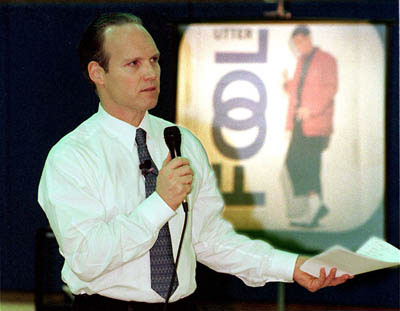
The Addiction
Let’s look at someone trying to quit smoking. For most addicted smokers, the addition is about half-mental, half-physical. This varies with each individual.
The physical portion of the addiction is to nicotine. The psychological part of the addiction is to the relaxing, familiar sensation of handling the cigarette, watching its curling smoke, the deep and relaxing breathing associated with inhaling and exhaling, the taste, and so on.
When quitting, a smoker’s conscious mind says, “I will stop smoking no problem.” But the unconscious mind has been conditioned that cigarettes give pleasure, and that’s all it can focus on.
The addicted, unconscious mind says, ‘Give me a cigarette now!’ It only recognizes what feels good, or what doesn’t feel good. It demands a cigarette without regard to right or wrong, and rebels against the conscious mind’s decision to not smoke.
During the process of quitting, however, a new habit of being a nonsmoker forms. The unconscious mind gradually gets used to not smoking, and the urges to smoke die away. See our cool Quitting Tips for more information on how to quit smoking.
Quitting
Once they get addicted, nearly all smokers try to stop a number of times. But most fail repeatedly at quitting, and many are never able to stop smoking.
Reality check: there is no product that works well. 85 out of every 100 quitters using the nicotine patch or gum go back to smoking within a year. Once you are hooked, there’s just no easy way out.
For smokers who quit without being in a program, it’s worse. 95 out of 100 of them return to the habit during the first year.
The lesson is clear: with no program, most smokers have only a 5% chance of success. With a program, the average quitter’s chances increase to 15%. So getting into a program triples your chances of quitting.
Not trying at all, of course, means that nothing will change. Quit smoking, but don’t quit trying — and know you can do this. If a parent smokes, they can too.
If you are smoking now or using chewing tobacco, I urge you to first admit to yourself that maybe you are using tobacco less out of choice, and more because you are addicted. Later, when you make a clear and firm decision to stop, getting support from a good program will help ease your way. In short, get help. See the school nurse and also go to our way cool Quitting Tips for more information on how to quit successfully.
Real men ask directions
People who are the most successful at living life typically get plenty of help. For example, in business, a successful businesswoman or businessman gets a lawyer to write the contracts, an advertising agency to create the ads, an accountant to do the accounting, a doctor when they’re sick, or a marriage counselor when their family is in trouble. In short, people who succeed best in life get help and lots of it. Even the greatest novelists in history usually had editors they counted on for valuable feedback prior to finalizing their books.
Students often get mentors, adults who look after and guide their careers, and share their knowledge. Ask an adult you admire and trust to be your mentor. They might say no, but don’t give up ask someone else. Choose someone with high morals and ethical standards, and don’t settle for less.
I experimented with cigarettes as a teen. I never thought I’d get addicted, but by age 18 I was completely hooked. For the next 17 years, I tried and tried again to quit. I failed a dozen times. I finally quit smoking in 1985, and have stayed smokefree since then. Quitting smoking was one of the hardest things I ever did.
In summary, if you are smoking, don’t be afraid to get help. If you are using tobacco now or experimenting with it, see the school nurse or talk to an adult.
Connecting with others is a big theme today. It’s okay to talk to someone and get help. If you can’t find anyone, get into an online program. Check our free Quitting Tips page for more info.
And if you haven’t started smoking yet, remember tobacco is extremely addicting. You can get totally hooked much faster than you think.
The best way to avoid getting addicted is simply to not smoke no matter what.
Smoking in Movies and TV
We uncovered this photo of an old ad for Lark cigarettes with Pierce Brosnan. It was seen in Japan. But Brosnan saw the error of his ways and has since shown leadership in the Hollywood community when he announced he would smoke no more as James Bond. His turnabout set a good example for other stars.
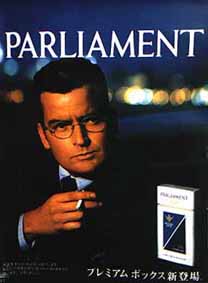
Charlie Sheen’s ad for Parliament ran in Japan. Mr. Sheen set a bad example for Japanese youth who look up to him.
For more info, see our page, Anti-smoking issues in TV and films.
Turning tobacco ads into anti-tobacco ads
In this powerful and motivating section of his anti-smoking assembly program, Mr. Reynolds discusses tobacco advertising. The vivid stories and facts he relates in his anti-tobacco talks are designed to empower youth to resist the onslaught of cigarette ads and peer pressure.
Using the anti-smoking ads below, Patrick makes great fun of tobacco advertising. He emphasizes that smoking looks very un-cool, and is no longer socially acceptable.
Both middle school and high school youth enjoy this section of his anti-tobacco assembly program. Humor is a key ingredient of his talks.
If cigarette ads told the truth, here’s how they might look.
We’ve all seen the ads for Marlboro Country, with images of beautiful country scenes, wild horses galloping, and rugged, masculine cowboys around a fire, or on horseback. Well, if tobacco ads told the truth, here’s what the real Marlboro Country might look like:

![]()
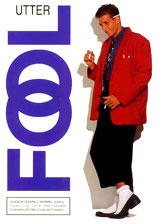
Mr. Reynolds shows these overheads. Anti-smoking art by Adbusters
Notice that we see several smokers, outside their office building in the cold, getting their fix of nicotine because they’re addicted. They’re not welcome inside the building. People just don’t want to be around their smoke. Often it’s not legal to smoke indoors because second-hand smoke can seriously hurt others.
The fact is, today almost four out of five people in the USA do not smoke. Nowadays, being a nonsmoker is the norm.
It’s difficult and painful to put up with the anti-tobacco attitudes so many people have today.
Why choose a path that is just about guaranteed to bring you rejection?
I don’t like the Utter Fool anti-smoking ad. Why? Because we’re calling somebody a fool. It’s just not a very effective way to communicate or persuade. The listener will just tune out if you call them a name.
I want to stop for a moment and talk about how we can better communicate with each other.
OK, I need a volunteer. I’d like someone who has a friend or loved one they want to ask to quit or to not smoke in the house. The other requirement is that you be able to give that person two honest compliments. He selects a volunteer.
Mr. Reynolds: So who do you want to ask to quit smoking, or not smoke in the house?
Student: My Mom.
Mr. Reynolds: Okay, I need a second volunteer to be Mom. Who wants to be Mom?
He chooses a student to play Mom. Students often laugh in delight at this.
Okay. Do you want to ask Mom here to quit, or just not smoke inside?
Student: To quit.
Mr. Reynolds: Okay. Start with an honest compliment. In general, that’s a good idea whenever you want to say no to anyone about anything. It’s helpful and effective to start with an honest compliment and a smile, and say, for example, “Hey, Mom, that dinner you made last night was great!” “Oh, it was?” Your parent or friend will open up, and will be all ready to really hear what you have to say next. Of course, your compliment must be true, honest, and from your heart. So what’s an honest compliment to give Mom, who’s standing right here?
Student: (Thinks) Mom, I like your hair-do.
Mr. Reynolds: OK, Mom, how does that feel?
Mom: That feels good!
Mr. Reynolds (to other student): Now don’t use but, as it totally undoes the nice words you just said. Instead, use and. Then follow with I feel, and tell them the emotion you are honestly feeling when you see them smoke.
Let’s see now, what feelings do we have to choose from? All of us have six basic emotions the primary colors of our hearts. We’ve got (he acts out using facial expressions and tone of voice) anger, sadness, joy, love, fear, and shame. And there’s a whole rainbow of sub-combinations. So what do you feel when you see your Mom smoke?
Student: I feel sad.
Mr. Reynolds: Any anger?
Student: Umm, yes.
Mr. Reynolds: Any fear? For example, that she might die?
Student: Nah.
Mr. Reynolds: So tell Mom here how you feel when you see her smoke.
Student: Mom, I feel sad and angry when I see you smoke.
Mr. Reynolds: Now, briefly tell her what you want her to do.
Student: I want you to quit.
Mr. Reynolds: Okay, now we need the second complement.
Student: Um, I admire how capable you are at work.
Mr. Reynolds: Great! (He turns to Mom) Mom, how does that feel?
Mom: Pretty good!
Mr. Reynolds (to student): Now put it all together.
Student: Mom, I like your hair-do, but I
Mr. Reynolds: No but! Use and. Okay, go again.
Student: Mom, I like your hair-do, and I feel sad and angry when I see you smoke. I want you to quit. And I admire how capable you are at work.
Mr. Reynolds: Excellent! Okay, Mom, how does that feel?
Mom: I like it!
Mr. Reynolds: Okay, well done. Let’s give these two a round of applause it takes courage to come up here! Thanks.
Here are some answers other students have given:
“Dad, I love the time you spend with me, like when you take me fishing with you or come to see me play in the game. Your giving of your time means so much to me. And when you smoke, I feel afraid and sad, and a little angry. I need you to stay healthy and be there for me and live a really long time. I need you, and I love you a lot!”
“Mom, that’s a nice dress you have on today. And you know, I feel sad, and a little afraid too, when I see you smoke. I want you to quit soon! I don’t ever want to lose you. I love you so much!”
“You’re my best friend, and we have a lot of fun hanging out. I feel afraid when I see you smoke. I’m worried your second-hand smoke will hurt me, and you too. I want you to put out that cigarette now, please! And you know what? I’m really glad we’re friends.”
Mr. Reynolds: In summary, if you call someone a fool, you lose them. They tune out. On the other hand, if you approach them in a warm, friendly manner and tell what you’re feeling, your friend or loved one will open up, and really hear what you have to say.
The result? You’ll be a more effective communicator. It’s powerful and very persuasive to express your feelings, and it feels good, too. We’ll come back to that.
~~~
Here’s another anti-smoking ad. Some of you will remember that not so long ago, the tobacco company my Grandfather started, R.J. Reynolds Tobacco, used a cartoon camel to promote its Camel brand. Most of us remember Joe Camel. He was cool, he wore sunglasses, and he was shown at the beach with girls in bikinis around him, or in front of fancy sports cars, or playing the sax, or hanging out at a pool hall called Joe’s Place.
Well, if tobacco advertising told the truth, here’s what Joe Camel would really look like:
Mr. Reynolds shows this slide.
Joe is lying down, sick from smoking! He’s got a needle in his arm to get the chemotherapy medicine, whose purpose is to cure, or at least slow down, his cancer. It made his hair fall out! His friends are all gone, he’s all alone, and his days as an athlete are over. And he’s in terrible, awful pain, and knows he’s going to die.
Joe might be saying, “I wish I hadn’t smoked. I conned a lot of kids into thinking smoking was cool, and I’m sorry! And I’m sorry I smoked. I’m dying of cancer. Just look at me now! Please whatever you do, don’t smoke!”
So that’s what tobacco ads would look like if they told the truth about tobacco and smoking.
He also shows slides of more recent ad campaigns targeting youth, including several of those below.
“How do you feel about their going after youth?” he asks, as he shows several of the images below.
In October 2006, R.J. Reynolds finally agreed to take its candy-flavored cigarettes off the market and to stop running ads associating them with alcoholic beverages.
Ads for R.J. Reynolds Candy-flavored Camel Cigarettes
Click each ad for a larger view.
Ads for Brown & Williamson’s Kool Cigarettes
Click each ad for a larger view.
The toll of smoking in the US and around the world
Some teens are not so concerned about the risk of disease later in life. But the fact is, cigarettes cause emphysema, lung cancer, and heart disease, and 4 out of every 10 smokers later die from their addiction to tobacco. Nearly all of them got hooked as teens.
According to a US Surgeon General’s Report issued in May 2004, smoking is even worse than previously thought. It damages virtually every organ in the body.
In the US, smoking causes 1 of every 5 deaths. Cigarettes kill 1,200 Americans every day a tragic death toll of 420,000 Americans each year.
Around the world, smoking now kills five million people every year. In the US, 20% of adults, or one in five, are addicted to smoking. But because smoking rates in Europe and Asia are so much higher, on average, one in three adults worldwide smoke. And smoking kills 4 out of every 10 people who smoke.
If we do the math, this means that in the coming decades, cigarettes will actually kill 500 million people and all of them have already been born. That’s nine percent of the present world population. It means that almost 1 of every 10 people now alive on earth will die because of tobacco use. These statistics come from the United Nations World Health Organization, headquartered in Geneva, Switzerland.
Every day in the US, 2,000 teens become newly addicted to smoking. Think about it: most will not be able to quit for 17 years, and over 800 of those teens will later die from cigarettes.
How do you feel about that?
More about tobacco advertising
Let’s take a closer look at cigarette advertising. Would you object to being manipulated mentally? Well, tobacco ads are designed to play with your mind.
In January 1998, Democratic Congressman Henry Waxman revealed some very secret memos of the RJ Reynolds Tobacco Company. In 1975, one executive wrote, “The Camel Brand must increase its share penetration among the 14 – 24 age group which represent tomorrow’s cigarette business.” Tell me, what feelings do you have about that?
A 1986 memo noted how the cartoon camel campaign would utilize “peer acceptance/influence” to “motivate the target audience to take up cigarettes.” How does that make you feel? I feel sad and angry about it.
Your conscious mind vs. your unconscious mind
So many teens tell me that tobacco ads have had absolutely no influence over them. I agree that tobacco ads will not change your conscious mind but they may be getting through to your unconscious mind more than you realize.
What is the unconscious mind? While your conscious mind is analytical and makes (mostly!) sensible, rational decisions, it’s your unconscious mind that often throws common sense out the window. It’s the creative part of our minds, and it cares little for right or wrong. It just knows what feels good or bad, regardless of the consequences.
For example, an overweight person may have made a responsible and conscious decision to diet, but their unconscious mind still remembers the sweet taste of ice cream. The conscious mind’s will to diet can be overcome by the power of the unconscious mind, and the memory of delicious ice cream. “Willpower” is literally the conscious will’s power to repeatedly resist the strong desires of the unconscious mind.
The story of Pavlov and his dog
The Russian scientist Pavlov used to ring a bell every time he fed his dog. Every day he would ring the same bell to call the dog to his supper. This went on for many months. One day, he accidentally forgot to put the food out, but rang the bell, thinking he had. The dog came running, wagging its tail, and Professor Pavlov was amazed to see the dog drooling its mouth-watering, as though the scent of food were in the air.
Pavlov realized that his dog had made an unconscious association between the sound of the bell and the smell of supper. His dog was salivating simply upon hearing the bell! He had “conditioned” his dog.
In much the same way, the cigarette ads we see in magazines build an unconscious association, conditioning us to make a connection between the deadly addiction of smoking and strong, positive images. In magazine ads, we see healthy young people playing sports which require breath, like tennis, windsurfing or mountain climbing. We see beautiful country scenes with campfires or wild horses galloping. We see attractive, adult role models many teens would like to emulate manly cowboys gathered in friendship around a campfire and successful, independent, and attractive women, who are role models for young girls.
How many weeks did Pavlov have to ring his bell before his dog finally drooled just hearing it, even though there was no food there? It didn’t take too long.
Through most of the 1990s, the tobacco industry spent about $5 billion each year advertising its deadly, addictive products. Incredibly, in 1999, they increased that amount by over 50% to $8 billion per year.
In 2000, they spent $9 billion on advertising, and in 2009, a staggering $13 billion. That’s a lot of bell ringing, ladies and gentlemen!
Cigarettes are the most heavily advertised product in the world. Tobacco advertising is a huge lie, and a deceptive manipulation on a massive scale. And all that advertising sends a powerful message to our unconscious minds, including the minds of our kids.
The sad truth is that cigarette ads have a much stronger effect on teens than most consciously realize.
In summary, the tobacco industry knows exactly what they are doing, and they spend billions every year to manipulate the unconscious minds of millions. Don’t let them manipulate you!
The truth about countertop displays
When you were younger, maybe this high, you remember seeing countertop tobacco displays in convenience stores and grocery stores. Day after day, year after year, they made tobacco look like a normal, acceptable product. You remember they placed them at child eye level, right next to what? [A student yells out, “The candy!”] That’s right, next to the candy. That’s where who is going to look? [“Kids!” they shout.]
How does that make you feel? [“Angry!”] It makes me angry and sad. For years, most of the tobacco companies told the stores, “Don’t worry about shoplifting. We’ll be happy to replace any stolen tobacco products at no charge.” And all they had to do was to sit back and wait until our kids became addicted.
Once they got hooked, the tobacco executives knew they’d have those kids as regular customers for about the next seventeen years. That’s the average time it takes a teen who gets hooked to finally quit, usually after several failed tries. And every year, those kids will be spending about $1,500 on cigarettes!
Today most states have laws requiring that tobacco be placed behind the countertops. But cigarette and chewing tobacco displays are still full view.
A quick show of hands, please how many of you already knew that the stores get up to $100 per month for each countertop display of tobacco in the store? [Typically] I see that almost none of you knew this.
Let’s tell the truth today. The store managers don’t put tobacco displays in stores because they think smoking is cool. Tobacco displays are there for only one reason the store owners get paid money each month by the cigarette companies to keep them there. Or, the stores get steep discounts on tobacco products, partly in exchange for the displays.
In recent years, the tobacco industry has spent a large share of its multi-billion dollar ad budget on these deceptive displays. Tobacco ads are no longer permitted on radio or TV, and there are fewer tobacco ads in magazines and newspapers. Tobacco billboards in the U.S. were removed in the late 1990s, as a deal point in the settlement of the lawsuit by the States against Big Tobacco. In addition to billboards, Big Tobacco withdrew its use of promotional T-shirts and hats, which for years had turned many kids into little tobacco billboards.
But even with the elimination of all that tobacco marketing, the tobacco industry still managed to spend $15billion on advertising in 2005!
In-store countertop tobacco displays and product discounting are now a major part of that spending. Temporary discounts on cigarettes make a pack of smokes much cheaper.
When the price of tobacco is lower, who do you think is more likely to try smoking, and later get hooked? You guessed it: kids. I believe it’s good to open your eyes to this.
How are tobacco displays deceptive? Tobacco displays make it appear to children that cigarettes are a perfectly normal product, like chewing gum or candy, and that tobacco is a customary and usual part of adult life.
In the early days, spit tobacco displays also created the false impression among the young that chewing tobacco was popular. Many young people thought, Lots of customers must be buying chewing tobacco, because if the store puts them right on the countertop or in plain view, they must be pretty popular products.
The truth is that not so many years ago, almost no one was using chew tobacco. These displays made it appear to be a product that was selling very well and this was a key element of the campaign to re-popularize chewing tobacco.
Tobacco displays, much like the ads in magazines, also foster the false impression among both youth and adults that smoking is socially acceptable. This inaccurate perception will continue, sadly, as long children grow up seeing tobacco displays almost everywhere.
We’d like to one day see tobacco placed under the counter and out of view. Existing addicts could ask for their brand by name, and kids and former smokers would not be tempted. Freedom of speech still protects tobacco advertising, but one day the courts may find this kind of advertising may be outlawed on the grounds that tobacco is an unusual hazard to the health of our children.
Today being a non-smoker is the norm
Almost four out of five people in the USA don’t smoke. It’s just not okay to smoke around most people, and it’s illegal to smoke indoors in more and more places across our nation.
As of November 2010, 28 States have now passed strong statewide laws requiring 100% smokefree restaurants and bars and 27 of them did it in the past eleven years! It’s a trend that has gained tremendous momentum. (California was first, in 1994.)
Banning smoking 100% appears to be an idea whose time has come. It’s popular with the great majority of the public as well.
Review
Smoking is much less socially acceptable than the advertising leads teens to believe. The tobacco companies spent $12.8 billion on advertising in 2009 up from only $5 billion annually just a few years before. A substantial part of that is being spent on in-store displays and promotional discounts.
Tobacco ads falsely suggest it’s okay to smoke around friends, and also create the impression that more people smoke than actually do smoke. Tobacco advertising disguises tobacco as a normal American product. Don’t buy it!
More and more teens are strongly anti-smoking. The rate of teen smoking has greatly declined in many states; in California, only 11% of teens smoke. Adults, too, often speak up about their anti-tobacco feelings. People just don’t want to be in the same room with smokers.
Two Recent Scientific Studies
If you’re a teen who believes advertising has no effect on you, consider this: one recent study demonstrated that advertising plays a greater role than peer pressure in getting teens to smoke.
Another recent study proved that the three most heavily advertised brands are the same three brands most chosen by teens Camels, Marlboros, and Newport. If you smoke, which brand do you usually use? Probably, you use one of these three.
So Why Is Cigarette Advertising Legal?
The First Amendment
So many teens have asked me, “So how come tobacco advertising is legal if smoking is so bad for you? Why don’t they just ban tobacco ads?” Here’s why.
The Constitution, of course, is the historic document that created our great system of government. After completing it, the great men who wrote it realized they needed to add on to it, or amend it. The First Amendment provided for Freedom of Speech.
The First Amendment means that if I choose, I can stand up on this stage and say publicly, The sky is purple! In my opinion, it’s purple, and the clouds are green! But if I lie, I will probably not sell too many videos or books, and the market will quickly sweep me aside. That’s one of the advantages of our market system.
Nonetheless, Freedom of Speech protects my right to say what I like in public. Sadly, it also protects the tobacco industry’s right to say what they like in their advertising, and to place tobacco displays in stores.
The world is not a perfect place. That’s one of the messages in my initiation into life, which I’ll give you before we say goodbye. Until now, we adults have done our best to shield your eyes from the bad in the world. It’s time to gently open your eyes to the fact that there is indeed some bad out there. In my opinion, tobacco advertising is part of that, and it should be banned or severely restricted. A private citizen should have every right to free speech, of course. But to my mind, advertising is quite a different kind of speech.
So for now, just because you see tobacco products in stores in attractive displays, it doesn’t mean cigarettes are a normal, acceptable American product like chewing gum or candy.
Let this knowledge empower you. Remember what I have said when you see tobacco ads and displays in stores.
Freedom of Speech was originally intended to protect every citizen’s right to say in public whatever they wanted to say.
Most judges in our present court system agree that the First Amendment protects advertising equally with private speech. One day, however, I have faith that the Supreme Court will see these forms of speech as separate and different, and will pass much stronger limits on tobacco ads also because tobacco represents such an unusual hazard to the health of our young.
Almost no one over the age of 19 becomes addicted to tobacco. New smokers are almost always children and teens and tobacco is a product as addicting as heroin or cocaine.
A further Initiation: Campaign donations to politicians
The second reason why I believe tobacco advertising has not been limited more by Congress is about money: the tobacco industry has given millions to politicians’ election campaigns. The world is not a perfect place. This is part of your initiation into life today.
Politicians and their parties use such donations primarily to run their election ads on TV, in hopes of being elected. They insist that the money they accept for their campaigns has no influence over the way they vote.
But recent studies have shown that members of Congress who accepted donations from the tobacco industry were several times more likely to vote the way the tobacco companies wanted them to.
The truth is that no corporation gives away millions of dollars without expecting something in return. Any executive who gave money away for no good reason would promptly be fired! Strengthening our campaign finance reform law should, in my view, be one of the highest priorities for the US Congress and our President.
As of July 2020, US elections are still flooded with advertising costing hundreds of millions of dollars, much of it “black money” from anonymous US-based donors. If you want to learn why this is possible, search the Supreme Court’s “Citizens United” decision. It should be repealed, and my opinion is there should be less money in politics.
Thanks in large part to our First Amendment and political donations, Congress has done little in the past to limit tobacco advertising. In 2009, however, under President Obama and the Democratic-controlled Congress, the Federal tobacco tax was finally raised by 69 cents, two weeks after Obama first took office. FDA regulation of tobacco was finally signed into law a few months later.
But Congress has also failed to make it harder for youth to buy cigarettes and flavored tobacco and vaping products, and there is no Federal bill to regulate smoking in the workplace. They did raise the purchase age from 18 to 21, however.
But the biggest, earliest progress we have made against Big Tobacco did not come from Congress, which of course is within the legislative branch of our government. It came mostly from our court system, or judicial branch. For example, in 1998, there was a $246 billion settlement of the States’ lawsuits against Big Tobacco to recover the cost of Medicare and Medicaid caused by smoking-related illness.
We have made progress in 30 or more State legislatures, but the tobacco companies remain powerful even at the State level. Our first progress came from the local level, from our city councils and municipal governments.
Big Tobacco’s settlement of the States’ lawsuits resulted in an agreement to end cigarette billboards, and the t-shirts and hats that turned so many kids into little tobacco billboards. Tobacco may still be advertised in magazines and newspapers, and may still be displayed on countertops in stores.
Our progress ending cigarette billboards and “gear” came from the courts, as a result of the settlement of the tobacco lawsuits. It did not come from Congress.
In summary, it’s far from a perfect world out there. Sadly, our politicians are too often influenced by special interest money. I believe this will change.
There are some good politicians who are presently more open to change, who are trying to reform our system of campaign finance. Some of my esteemed colleagues in the anti-tobacco movement are working hard for this, as well as for new anti-smoking laws.
In conclusion, just because you see tobacco ads in magazines, and displays in convenience stores, it doesn’t mean that tobacco is acceptable or safe. The world isn’t perfect! So be smart don’t let these deceptive tobacco ads mislead you.
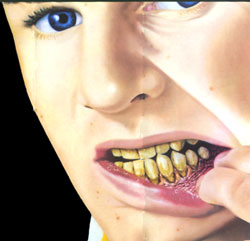
Dip Tobacco
Chewing tobacco was popular around 1900, but after cigarettes became fashionable, less and less people used dip tobacco, and it nearly disappeared. By the 1950s and ’60s, very few people chewed.
When the U.S. Tobacco Company began its ad campaign to re-launch their chewing tobacco products, they advertised on TV and in print media. But they did something few people knew about.
Earlier, I asked for a quick show of hands to see how many of you already knew that the tobacco companies pay stores around $100 per month, often more, to keep those displays of tobacco on their countertops, or just behind them. We saw that very few of you were aware of this.
Ads for U.S. Smokeless Tobacco Co.
Click the ad for a larger image.
US Tobacco and others paid grocery stores and convenience stores all across the nation huge amounts of money to place chewing tobacco displays on store countertops everywhere. Without those payments from Big Tobacco, countertop displays of tobacco products would quickly be removed.
As we discussed earlier in the section about tobacco advertising, countertop dip tobacco displays created a false impression among too many young people. Many assumed, Lots of people must want these products. If the store puts them right on the countertop, they must be popular. Dip became popular in large part because young people were deceived into thinking it was a popular product, and also acceptable. After all, there was the dip tobacco, right on the countertop often alongside the chewing gum and candy, where the eyes of children are sure to look.
Many of our young see tobacco displays every day, and have since they were very small. Do you remember seeing them?
Millions of kids got fooled. Day after day, month after month, year after year, seeing those displays in convenience stores, many were curious and eventually tried dip. Too many then became addicted and of course, regular customers. And U.S. Tobacco began making big profits.
Another problem with these displays was, it wasfar too easy for youth to steal cigarettes or chewing tobacco. They often faced conveniently away from the cashier, where tobacco was easy for kids to shoplift.
In some States, laws have been passed requiring stores to keep the displays behind the counter, out of reach. In some States, they are starting to cover them with plastic.
But the tobacco displays are still right on the countertops in many States. And either way, they are often at child eye level.
How do you feel about that? It makes me angry and sad, and my feelings help me renew my commitment to the anti-smoking cause.
I personally believe that to protect our youth, ‘spit’ tobacco, along with cigarettes, should be kept under the counter, totally unseen by customers. The old saying applies: out of sight, out of mind. Then only already-addicted, existing customers would think to ask for these deadly products by name. For now, though, Freedom of Speech protects tobacco advertising.
The U.S. Tobacco Company makes several brands of spit tobacco. The one many kids start out on is Cherry Skoal. It has the weakest nicotine bite, and is sweetened with cherry flavoring a taste not unlike candy. And these products are often placed next to the candy in convenience stores.
Many who try it become addicted, and usually move on to another brand with more nicotine, to satisfy their powerful new cravings. U.S. Tobacco makes several brands, with varying amounts of nicotine.
The brand with the most nicotine is Copenhagen. US Tobacco actually had the gall to take out one ad which read, “Sooner or later, it’s Copenhagen!”
A True Story about Spit Tobacco

Sean Marsee at age 17.
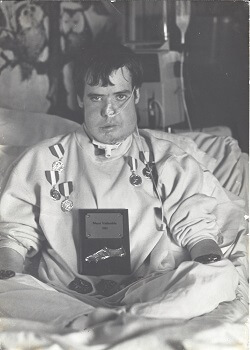
Sean Marsee at age 19, just prior to his death.
Patrick shows these overheads
as he tells Sean Marsee’s story.
At age 19, Sean lay in bed, sad and in pain. His best friend, who had been told Sean didn’t have much longer to live, came down from Chicago to see him for the last time. On first seeing Sean, his friend fought back tears, thinking of the great times he’d never get to have with Sean.
The next day, as they visited, he asked, “Sean, what if we took a photo of you like this?” But Sean shook his head, glaring, and wrote down emphatically, “No, not like this!” He was overcome with shame and embarrassment at the idea.
But his friend persisted, “What if other teens could see the photo, and learn the truth about what chewing tobacco really does?” Sean reflected on this for a while. Finally, he allowed this picture to be taken, with his track medals pinned to his chest. It’s his gift to you.
His friend got another idea. “Sean, what if, by some miracle, you could get a message to other teens? Do you have any words you’d like them to hear?” Sean nodded because without his tongue he could not talk and he gestured for pen and paper. His hands trembled and his eyes welled as he began to write, perhaps in part from the pain he was in. He struggled to write down these words, as his message to all of you: “Don’t dip snuff.”
And not too long after that, Sean expressed a simple affirmation of his Christian faith, and died sad, disfigured, and in terrible, unspeakable pain.
So let’s take a last look at these pictures, and thank The American Cancer Society, Sean’s family, and most of all, Sean himself, for this gift. We will remember you, Sean Marsee, and learn by your tragic death at age 19. We will remember.
The story of Sean Marsee is available in greater detail here.
Our thanks to the Marsee family for allowing us to reproduce these photos. We were pleased to see that a USA Today anti-smoking column wrote of our presentation of Sean’s story, “This was probably the most effective argument found online.”
WARNING
If Sean Marsee’s story moved you, the before and after photos of Bryan Curtis are even more powerful and moving. This link is not for the faint of heart!
Summary and Review
Chewing tobacco was made to look like a popular product when the U.S. Tobacco Company paid convenience stores to place their addictive products on countertops. Thousands of teens across the country assumed that chewing tobacco must be really popular. Eventually, many teens tried it and soon became addicted.
Remember, six out of every ten U.S. smokers started smoking before age 14. Nine of every ten smokers became addicted before reaching age 19.
In other words, almost no one will start smoking after 19! Nearly all of the tobacco industry’s new customers are teens. Who are the only new recruits the tobacco companies can get? It’s you the young.
How do you feel about that?
Be smart, and don’t be fooled. And remember how very addicting tobacco really is.
On How To Study
[For middle schools:] I’m going to ask you a question in a moment. But first, I want you to keep your eyes me, stay very quiet and not talk to your neighbor. You guys are being so great today! That’s how we learn, we keep our eyes on the teacher, don’t talk to friends, and listen. When we listen to the teacher, we learn.
[For high schools and middle schools:] When we don’t understand something the teacher says, the students who will succeed best in school raise their hands and ask questions. Remember, people who succeed best at life get help. To review, in business, a successful businessperson gets a lawyer to write the contracts, an advertising agency to create the ads, a doctor when they’re sick, and so on. People who succeed ask for help. Ask your teachers and parents questions it’s good to ask, and it’s okay to ask. Real men do ask for directions!
By the way, how do we study? It’s called Butt Power you keep your butt in the chair and your nose in the book. Excellence takes just a little extra effort and focus. Highlighting is good, and if you have time, go back and read what you highlighted again. And always ask questions when you don’t understand.
We hear a good deal lately about the excessive homework being assigned today. If enough families speak up, schools will respond, and we will see change. So let your feelings be known about that.
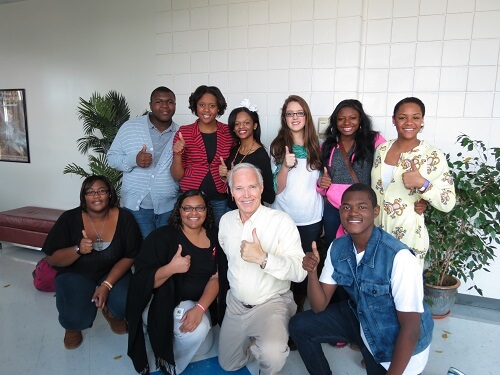
On Ethics
In the past, it has been far too easy for children to steal cigarettes. All the tobacco companies had to do is to sit back and wait until they got addicted. It only takes 2 weeks in many cases. When you do get hooked, your cigarette addiction will cost you $1,200 per year or more to maintain and it’s possible you might never be able to stop.
So here’s my question. Let’s see a show of hands: How many of you know of a friend who has stolen cigarettes? [In most middle and high schools, from 1/4 or more of the hands go up.]
That makes me feel sad. Let’s have a talk about ethics. I’m going to give you three good reasons to be honest.
First, there’s our relationship with our community. It really hurts our community when we are dishonest and that means it hurts the people around us.
It hurts our parents, our friends, and our neighbors. And we hurt our own good feelings about ourselves our self-worth and our self-esteem.
The fact is, we are all models of ethical leadership for each other. When we do the right thing, we lead our friends in a good and honest direction. You influence your friends positively when you refuse to use cigarettes, drugs, or alcohol. If you steal, you lead your friends in a dishonest direction. And your example really does influence your friends. If you say yes to these things, you’re hurting yourself and your friends.
Second, how we feel about ourselves is really important. One of the best reasons I know to be honest is that it just plain feels good. And it feels bad when we do something we know to be dishonest. For example, it’s so painful to hide and tell a lie, or to keep a deep, dark secret when we have done something wrong. Guilt and shame are very uncomfortable to bear. They’re very costly emotions. Telling the truth, and being honest, lightens our load and sets us free.
It’s really very simple. It just plain feels so good to be honest.
On Secrets
[For middle schools:]Mostly I don’t like secrets the secrets of your best friends your own age are okay. But if you’re carrying a deep, dark secret, or feel like you have done something really wrong, it can feel like you’re carrying around a 100-pound weight everywhere you go.
Find the courage to talk to your parents about it. If you can’t bring yourself to talk to your parents, then talk to a trusted teacher, your friends, and especially to the school counselor. That’s what they’re there for. It’s so good to talk to someone and it will be okay, no matter what.
Don’t carry a huge secret alone. When you talk to someone, it’s like setting that 100-pound weight down, and suddenly you’re free of it. So don’t hold back. Don’t carry your secret silently, whatEVER it may be. Remember, students who succeed best usually get help so speak up and talk to another person!
Telling the truth really does set us free.
What Can I Do If My Parents Smoke?
I get asked this a good deal, and my answer might surprise you don’t be a NAG about their smoking habit!
That’s right don’t be an anti-smoking fanatic! Instead, ask for reasonable changes.
For example, it’s appropriate to let your anti-smoking feelings be known if someone smokes in the house or near you. It’s okay to speak up because their second-hand smoke hurts you.
But don’t nag them to stop smoking. There’s a big difference!
That said, it’s okay to ask family members to quit smoking but I’d recommend asking them no more than three times a year. Be brief, and try to use loving tones and words. Sandwich your request between honest compliments, and family members and friends will become more open to hearing you.
We’ve already seen a fine example of this today, in the earlier demonstration with the volunteers who so bravely joined me up here.
If you ask a loved one to quit more than three times per year, you’re a yucky, obnoxious nag! If you deliver your anti-smoking feelings more than this, you may make them so angry that they will keep on smoking, just out of anger and stubbornness.
Sohonoryour smoking loved ones, and treat them like adults. Don’t harass them about their habit, or nag them with your anti-smoking views. Let them decide to quit smoking by themselves, when they get ready. That’s often the best way to open the door for them to stop.
You do, however, get to be a pest about second-hand smoke. That hurts you, so it’s your business. But you don’t get to nag a loved one to quit their addiction.
Examples of how to ask a friend or loved one to quit
Remember, as we did in the demonstration, sandwich your “No” between 100% honest, positive statements. Do your best to talk about your feelings speak from your heart. For example,
“I love being your friend, and I value our friendship. And I feel angry when you smoke. I don’t want to lose you. I want us both to live for a very long time.”
“Hey, Dad, thanks for taking me to the game last Saturday. I had a great time with you. And you know, I get afraid when I see you smoking. I need you to live for a long time. I love you, Dad.” The key is to express what emotion you are really feeling, in this case, fear and love.
“Mom, that dinner you made last night was great! And I feel sad when you smoke. I really love you, and I need you so much!
Honest compliments motivate people
Try a compliment like this one: “Dad, you’re wise and responsible. I’m sure you’ll quit smoking whenever you get ready, and when you get around to it. I feel happy when I remind myself, of course you’ll make a smart choice about tobacco! I have so much faith in you I just think you’re the greatest, Dad!”
In this last example, you didn’t nag your Dad, or even ask him to quit. Instead, you told your Dad only genuine and positive things. (If these don’t fit you, try to find complements that are genuine and honest.) This last example follows the slightly more advanced formula described just below, in “What Parents Can Do” except now you’re using this idea on your parents!
In summary, whatever you do, don’t be a nag about anyone’s addiction to smoking. Remember, you only get to ask parents to quit three times a year. But you do get to be a daily pest about second-hand smoke in the house, because that hurts you.
What parents can do to keep their children smokefree
Whenever you see your children do anything responsible,immediately reinforce them. Remark on it right away! For example, if one brushes their teeth or cleans up without being asked, say without hesitation, “That’s terrific that you did that. You really are such a responsible young man / lady!”
The child gets the idea that they really are responsible after all, Mom / Dad must be right (or how would dinner be on the table?)
Your child accepts just about whatever you say so when your child says or does something wise, smart, helpful, or responsible, remark on it. You will build your child’s self-confidence and self-esteem and you will also deeply instill in them the belief and simultaneously create the reality that they are indeed responsible.
Later, when it comes to the teen years, you will be able to justifiably say, “Honey, I’m not worried about you, when it comes to smoking / alcohol / drugs / or the opposite sex. You’re a very responsible person so I know you’ll make a responsible choice about all these things.
“On the other hand, when the parent worries, the child gets a message that they must be irresponsible. The child thinks, ‘Mom looks so worried that I might smoke / use drugs / etc. Why does she get that worried face when she looks at me? Oh, I know I must really be irresponsible. Okay, she’s right, I am. So, I’ll go do these things! It’s who I really am!‘
“Or the child says, ‘Dad just called me stupid, so I must really be stupid. Okay, so I’ll get bad grades. After all, I’m stupid! Dad must be right…’ And so on.
Modern psychology tells us the firstborn is often the “hero” in the family. But try not to lavish most of your compliments on your oldest child. If the oldest child gets most of the reinforcing positives from parents, a younger sibling may later feel able to express their individuality only by taking a less than heroic road. My older sister gets the good grades, and she gets rewarded for it a lot. She is so smart! I must be the poor student. She’s always getting compliments about it, and it seems like I get none.
Psychologists have added that a middle child is often the “caretaker,” and that the youngest child is frequently locked into the “cutie-pie mascot” role, sometimes for life. So try to let all your children be the “hero” in turn, by distributing your praise and displeasure more evenly.
Give your children lots of positives, but only when they really deserve it. A child knows when you’re blowing smoke.
Telling your child you know how responsible he/she is will build your child’s self-esteem, and will help them to make more responsible choices about not only smoking, but also about alcohol, drugs and other high-risk behaviors, later on.
So be generous, and quick to respond with honest compliments. If this is not the usual language spoken in your family of origin if it’s not the way you were parented then that’s all the more reason to try this new idea.
Becoming an Adult
Some teens take up smoking because they think it makes them look older, but it doesn’t. To most people it just looks like you’re making a big mistake, and like you’re trying to make yourself look older.
There’s no rush, you know. It’s okay to be the age you are. It’s okay to be yourself, right here and right now. I advise you to enjoy the present, and all the good moments your unique and special life brings you.
[At high schools] All of you are now in the process of crossing the bridge from childhood to adulthood. You’re moving at your own pace, and you should be. In the teen years, things can start moving more quickly, like rapids when a river gets narrow.
- It’s actually normal to have very intense feelings sometimes,
or go through a rebellious period. - It’s actually normal to feel as though you are apart from most everything and everybody.
This is part of the normal process of establishing your own identity and personality apart from everyone else’s. These feelings are okay, and mostly they are appropriate.
You may, for example, find yourself saying “No!” more to adults, or questioning your parents and teachers. You may find yourself easily flushed with anger, shame, joy, love, or other strong emotions. All this is part of the passage to adulthood in the teen years.
Whatever you do, please don’t make the mistake of risking getting addicted to cigarettes, drugs or alcohol in your efforts to set yourself apart from and establish your individuality. Remember, it often takes just two weeks for 11 to 13-year-olds to get hooked on tobacco.
If you feel angry, don’t turn your anger inward, on yourself by smoking, or by becoming addicted to drugs or alcohol.
If you do, you hurt only yourself, and you may not ever be able to stop. These addictions have a very good chance of killing you. So be smart, and do your best to make responsible choices.
Cigarettes are yesterday’s news they are on the way out. If you get addicted to smoking, you’ll be on the way out too.
Initiation Reviving the ancient tradition
Now we come to a very special part of my talk. Today we’re going to revive the ancient tradition of initiation, largely lost to modern society.
For many thousands of years, on every continent on the globe, the older members of the tribes would take the younger ones out into the forest or desert for an initiation ritual. This was done in diverse societies all around the world. Even though they had no way to communicate with each other, people seemed to know intuitively, or by time-honored tradition, to have a ceremony to initiate adolescents, and welcome them to the world of adults.
Most initiations would last from 2 to 3 days, but some went on for longer. Initiation almost always involved making the younger ones uncomfortable, often by depriving them of sleep or food, or inflicting other hardships, and putting obstacles in their path.
I could never understand why the adults would do this, and I pondered it now and again over the years. One morning, though, I got it and understood.
I believe the purpose of inflicting difficulty during initiation was to let youths know that life is sometimes hard and that they could handle those times, as they arose.
It was as though the elders of each tribe were saying,
While you were a child, we wanted to shield you from the difficulty and struggle in this world, as much as we could. But now, you’re entering the adult world. To forearm and prepare you, we are letting you know in this ceremony that life will be hard at times. And you can do it. Welcome to adulthood, and welcome to life! At the end, the elders always warmly welcomed the youths into the world of adults.
I’m going to take a few moments now and initiate you. I’m not going to inflict physical pain or conduct any rituals today, so don’t get nervous! I will only give you the essence of the message, which begins with the awareness that life will sometimes bring you hard moments and obstacles.
I believe things are designed that way for a good reason. Life is not meant to be easy. It’s by our struggles to succeed against adversity that we define our characters and become strong men and women. It’s by staying with whatever pain and difficulty life brings us that we heal, and solve our problems — not by running away like cowards.
So when the painful moments come, as so many adults do, don’t make the mistake of altering your mood and avoiding the problem at hand by using cigarettes, alcohol, or drugs. People who continue to use tobacco are avoiding the pain of nicotine withdrawal.
To avoid their discomfort, many teens also use things that aren’t normally harmful, such as TV, music, food, or even turning on the computer and going to work.
Don’t take the easy path! Only a baby gets instant gratification. Adults have to delay gratification and wait for it. Instead of these distractions, face your uncomfortable feelings head-on, and begin to solve the problem.
Above all, talk to a trusted teacher, the school counselor, your friends, your parents — connect with another person. If you keep your problems to yourself and bear them all alone, you’re making a mistake and the problems will linger on as the years go by.
It’s by talking about our difficulties to another person that we heal and solve them. Stay with your problem, talk about it to others, and take steps to solve them. You can do it!
That’s it you’re initiated, and closer now to the world of adults. Welcome!
Our Multiple Addictions
John Bradshaw once called America “a nation of addicts”. In addition to smoking, he said that many adults also get addicted to food, alcohol, drugs, music, TV, computers, movies or even to work. “We are poly-addicted,” he said.
He says that we are really trying to avoid one thing: our pain. Tony Robbins has also said that we seek to avoid our pain.
Mr. Bradshaw points out that when we alter our mood with substances or diversions like these, we just temporarily numb our pain, or divert our attention away from it and we don’t solve the problem which is the cause of our pain.
The solution: instead of smoking, or running to the icebox door to alter your bad mood, stay with what’s bothering you. Think about what’s causing the uncomfortable feeling, identify the cause, talk about it to others, and take action to start resolving it.
Life was not meant to be easy it’s supposed to be difficult. It’s designed that way!
Some commonly held teen beliefs but every statement below is false.
I’m invulnerable and nothing can harm me.
Taking risks with cigarettes/drugs makes me look cool to other kids.
Smoking/ chewing/ drug use/ alcohol makes me tough.
Mouth cancer? Lung cancer? It won’t happen to me!
I can stop anytime.
I could never be a smoker / alcoholic / drug addict.
I could never get a disease from smoking or chew.
Athletes chew. It must be safe.
I’ll could never get AIDS.
Sean Marsee died at 19 from chewing tobacco. You’ll never get AIDS? Just ask a teen who’s HIV-positive, and who may have their life cut short by that disease. You won’t get addicted? Ask a teen drug addict or a teen alcoholic. This is very, very sad.
Photo by Visible Light /Mickey Krakowski
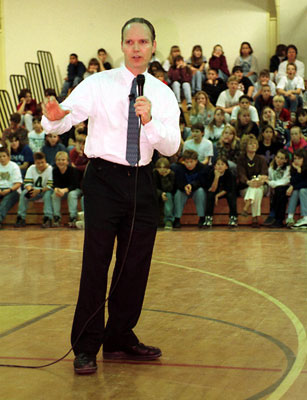
Keep your hopes for the future strong
What caused the dramatic 73% teen
smoking upsurge from 1988 to 1998?
In 1988, the cartoon figure Joe Camel was introduced. An important CDC study found there was a huge and mysterious upsurge in the amount of teen smoking between 1988 and 1998. In those ten years, teen smoking in the US increased by a staggering 73%! At the time, learning this made me sad, and made me angry, too.
Fortunately, in 1998, smoking began to trend downward again among middle and high school students, partly as a result of the increased spending on tobacco prevention campaigns in some States. In October 2001, Health and Human Services Director Tommy Thompson announced a new study showing a dramatic 30% drop in the rate of new teen tobacco addiction. But cigarettes, JUUL and vaping skyrocketed among teens, and we covered that.
What caused the huge 1990’s upsurge in teen smoking? One CDC study said there were two major factors to blame. First, it blamed cigarette ad campaigns that targeted the young, such as Joe Camel and the Marlboro Man. Second, the study said that smoking by movie stars in films and TV had played an important role.
But there is one factor which went unexamined, and which I believe was another significant reason for the 1990s increase in teen smoking. During the ’90s, many teens began having increased doubts and anxiety about the future. Many students, especially youth at risk, may have felt,I have no future anyway so why not smoke or try drugs?
According to a 1994 study by Coca-Cola’s marketing department, large numbers of teens felt they faced a bleak future. When conducting market research for their ad campaign for OK soda in the early ’90’s, Coca-Cola executives discovered that US teens suffered from “an acute sense of diminished expectations.” They found that many were pessimistic about their future job prospects, and were excessively anxious about the future.
I believe this helped start the attitude among some, Let’s party now! Who cares if I smoke, drink, try drugs, or expose myself to Corona virus? The future is looking pretty bad. I’m angry that the adults really screwed things up. I just want to have some fun while I can.
The tragic events of September 11th, 2001 significantly increased student doubt and worry about the future, and the two decades which followed made it worse with a wave of new crises: opiate addiction and death in the US exploded, 2008 saw a devastating economic collapse, world peace receded, and global warming continued unchecked. Then the Corona virus caused hundreds of thousands of deaths and threatened the world’s economies.
Add it up and the need for us to rebuild and restore our kids’ faith in the future is greater than ever — and it will also motivate our youth to stay healthy. So let’s do that now.
If you feel pessimistic, worried or anxious about your future
1. Talk about it to parents, a trusted teacher, the school counselor, and friends
2. Think positive. Below are some examples
3. Reevaluate: what is real wealth, anyway?
4. Develop your faith in the future. The truth is that the coming years hold tremendous promise.
5. Conclusion: avoid tobacco, drugs and other high-risk behaviors, because you’ll need your health in the incredible times ahead.
First, talk about your worries.
How do you feel about your future?
Are you optimistic or are you more of a pessimist? Does your future look reasonably bright, or pretty dim to you?
If your future were decidedly dim, and the adults really did mess things up, you’d be 100% right to be angry. But taking your anger out on yourself hurts mainly you. Some teens express their anger by smoking, drinking, or using drugs. That would hurt your parents, but the person you’d most hurt is yourself.
Any of these can seriously damage you for life, and could destroy your entire future. Don’t listen to so-called friends who tell you differently. Limit them by telling them no, and really use the formula we learned above for limiting friends.
If you feel some anger, fine, go ahead and get it out: “I’m angry about the…” Say it to your parents, to your friends, or to the school counselor (a very smart move). Express your feelings and talk to someone! Remember, those who get help tend to be more successful in life.
Whatever you do, don’t make the error of hurting yourself with your own anger by smoking, drinking, using drugs, or other dangerous, addictive behaviors.
It’s by talking about our feelings, as soon as possible after they happen, that we heal. When we instead numb out and pretend everything’s fine, our anger, sadness, and hurt just build up inside. After a while, we forget why we were angry, fearful, or sad in the first place and we take it out on ourselves, hurting ourselves with tobacco, alcohol, or worse.
So talk about your feelings to family, to friends, to a trusted teacher and especially your parents or the school counselor. Find someone you feel completely safe with and talk about what’s on your mind. That’s the best way to fix the problem. Talk about what makes you angry, sad or afraid. Talk to someone, and it will help solve the cause of the problem.
Think positive
While it’s good to let your negative feelings out and talk to others about them, it’s also smart to try to keep a generally positive outlook.
Where is it written in stone that your future will be dark? Negative thoughts like those below on the left will pull you down. They will hinder your progress toward your goals.
On the other hand, positive thoughts like those on the right will help to propel you forward in life. Thoughts like these will help you reach your goals, and help make your dreams come true.
| NEGATIVE THOUGHTS PULL YOU DOWN | POSITIVE THOUGHTS PROPEL YOU FORWARD |
|---|---|
| There won’t be a good job out there for me. | There will be an excellent job out there for me. |
| I could never own my own business. | One day I can own a business if I want to. |
| I have no future. | My future is looking fine! |
| I have a poor memory. | I have a good memory. |
| I can’t do this. | I CAN do this. |
| That person won’t like me anyway no point in saying hello. | That person will be glad I said hello; so what if we don’t become friends? I’m saying hello! |
| I’m not a very likable or valuable person. | I am likable, and I make a great friend. |
| I feel mentally off, defective somehow. | I have a good, perfectly fine mind. |
| The country is going downhill. | Things are getting better. |
| The whole world is going downhill. | The whole world is becoming more aware and honest. |
| Life stinks it’s too hard out there. | Life is great! I’m going to do just fine out there! |
| My parents seem to have even less money now than they did just a few years ago and they both work. | My parents may not have much money, but we have a LOT of happy times. My parents like their jobs, and would rather work than stay home all the time. |
| What’s going to be left for me? | The world has so much to offer me there will be PLENTY! |
| There’s no future for me. I may as well have fun now. | I have an amazing, wondrous future, and I’m NOT going to blow it by making irresponsible choices and tragic mistakes. |
Does your family frequently say positive things? Or do they tend to make more negative statements? What about your friends? How do you feel about this? Does it make you happy or angry or sad? Does it mean you have to think the same kind of thoughts? Do you choose friends who think this way?
It’s important to talk to adults about your negative feelings, but don’t get too carried away with them. Most of the time, try to think positive. Notice how you start to succeed more.
What if thereareleaner times ahead? What if tough times are already here for your family?
Are you angry about it? Does that mean you just give up and throw your whole future away on tobacco, drugs, alcohol or take other irresponsible risks?
Life’s painful times give us a gift: they increase our soulfulness, and they build our spirituality. Difficult times also bring us closer to our loved ones. Our struggles help to strengthen our character, and help us find out who we are.
And by talking about our feelings of sadness and/or anger, we heal our wounds and become stronger.
Yep, real men do talk about their feelings. They are actually more powerful, masculine and successful than those who close off from others and isolate.
Reevaluate: What is real wealth?
What is real wealth, anyway? TV sends us strong and repeated messages that to be “wealthy” we must buy more products, and spend more money. Our whole present economic system is based on the yearly growth of the economy. Our culture emphatically tells us that consuming more every year is both necessary and good for the world. Our shopping malls are shrines to buying more and still more things which often, we don’treallyneed. This is the wrong direction for us to continue in. We must find the courage to change, and leaders who will help us change, because the world has a limited amount of renewable natural resources, and many people now feel we should make efforts to consume less, not more, in the future.
The fact is, as poorer, less industrialized nations develop their economies in the “Third World”, their peoples will start to consume as much energy and resources as we do. This is already happening on a large scale in China and India. The truth is, our planet will no longer be able to sustain the greatly increased rate of consumption of the earth’s natural resources.
I’m optimistic and hopeful, however, that these issues will be solved, through intensified exploration for natural resources, through greater conservation and perhaps, through a fundamental shift in our perception of what wealth really is.
Television commercials suggest that owning material things will bring us happiness and fulfillment. Shampoo ads cunningly imply that their brand of shampoo will actually make us better looking.
These TV ads slyly, and falsely, suggest that owning this article of clothing, or that kind of car, will actually make us more successful with the opposite sex. All this is very far from reality.
The truth is, the thing which makes us happiest is our relationships with other people.Our ‘inner lights,’ or personalities, are what most attract friends, as well as the opposite sex not possessions.
TV, however, implies that without buying these material things, we can’t be happy, sexy or fulfilled. This is simply a lie. Cigarette ads are just one of many examples. The material things advertised everywhere in our culture are just that onlythings! We need to turn away from our nation’s intense focus on the material.
The more we get, the more we want. And the more we want, the more frustrated and unhappy we become. Our goals continually seem to recede further and further beyond our grasp.
I believe the most profound and deepest form of wealth is simply knowing this: I already have enough.
Now, some of you may be thinking,Ha! That’s easy for you to say you’re rich!So let’s talk about that. Most of my family’s money went into foundations and to charity, because my father wanted his sons to work. He worried we wouldn’t work if we had a lot of money, so he did not leave us much.
But I feel like a very wealthy man not in dollars, but inrealwealth.
In one sense, real wealth is to be freed from always wanting more than we now have. When weknowwe have enough, we are truly wealthy and far happier, too.
The bookYour Money or Your Lifeby Joe Dominguez and Vicki Robin develops this idea. It makes a strong and moving case for simplifying our lives, and has influenced a great many people in the US.
For many people, real wealth is about family, and the love we get at home. For some it’s about fun times shared with good friends. For others it’s about joy of a life spent together with a special someone. For many it’s about children. Real riches are also found in good health, one’s positive memories of a life well-lived, or the simplicity of just enjoying a beautiful winter or summer afternoon.
True wealth comes, too, from our good feelings about ourselves our pride in our inner selves. Feeling good when you are alone is also a sign of wealth.
Real wealth can also be about your connection to God, to your own higher power, or however you may think of that.
In conclusion, don’t fall victim to all the materialistic messages coming from television and the advertising industry and remember what real wealth is.
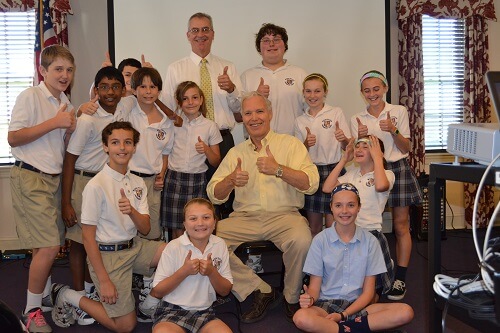
Develop your faith: The coming years hold tremendous promise.
Our society is now changing rapidly. What if in the future we come across a few lean months or even years? What if the lean times are already here for you?
Personally, I have a strong conviction and faith that any tough times will pass, and the world will once again become a very bright and positive place. We’ve had recessions in the past, and the economy always came around again.
I want to share my vision with you, and the strong feeling I carry deep inside. I believe that something great and wonderful is coming our way, and that good times will follow any possible difficult period, as surely as the sun will rise tomorrow.
Call it mystical, call it irrational, but you can’t take that feeling away from me, or convince me otherwise. I’m sharing it with you now, in hopes that it might plant the seed for you to catch my faith in the future.
I’m convinced that over the long term, things will be okay no matter what.
Thinking positive is a form of faith and it really works. Develop your ability to think positive thoughts, and soon you will see very real results. Try it and see!
Scroll back and reread the Positive – Negative thoughts table above. Write out your own list of positive thoughts.
I have faith that the future is looking great, no matter what happens in this world.
Share my vision, and don’t hold yourself back by worrying about the future. Think positive thoughts as much possible.
Practice this, and develop your faith that all will be well. Others will catch your enthusiasm, and you will be more successful in life.
Conclusion: Hold on to your health you’ll need it in the terrific times ahead!
In conclusion, you’ll need your health every precious bit of it in the wondrous times ahead. So avoid tobacco, drugs, alcohol and other high-risk behaviors.
Make responsible choices now. Lead your friends in a good direction, by not smoking, and not using drugs. Make the smart choice. Don’t risk becoming addicted to cigarettes, alcohol or drugs.
Consider the incredible future that’s coming your way. You’ll need your body to be in excellent health, to enjoy the long and and wonderful life you have ahead of you in the 21st century!
A Fork in the Road
I came to a big fork in the road in my life with one road leading the right way and another leading the wrong way. There were signs the signs pointing in the wrong direction said, ‘Easy Way This Direction,’ ‘Familiar Territory,’ “Smooth Road Ahead,’ ‘For Comfort, Right This Way’. The signs pointing in the direction I knew was the right one said, ‘Danger Ahead,’ ‘Unfamiliar Territory,’ ‘Steep Uphill Climb,’ and ‘Rocky Road Ahead.’
Each of you will come to many such forks in your own live paths. When you do, remember this moment and think, before taking the easy way. Choose the road you know is right.
A Vision and a Promise
In closing, I want to share with you my vision that we will have a society free of tobacco, one day. One day there will be no more mothers and fathers who die early because of cigarettes. There will be no more kids getting addicted to tobacco, because tobacco will be a thing of the distant past.
You’ve all been listening so attentively, it tells me each and every one of you is a responsible young man and woman. I have faith in you, and I’m not worried about you. I believe you will make a wise and responsible choice about smoking, and about drugs.
You are a citizen of the 21st Century and in the 21st Century, smoking will be no more. I promise you that it’s going to happen and it will happen because of you. You are the future.
Q & A Session
Thank you very much. I’d like to open up now to some Q & A, so those of you who have questions or would like to make a statement, I invite you to do so now.

The Q & A sessions following his talks
always captivate young audiences.
It is Mr. Reynolds’ hope that young people will print out the message above, show it to their teachers, friends, and family, and take time to discuss it together with them. He is also hopeful that teachers will share some of the ideas above with their students.
A new educational DVD of the live talk above is available. The Truth About Tobacco is fully illustrated with film clips, cool graphics, photos and great anti-smoking TV spots. It was created for 6th through 12th grade. Click here to learn more.
Preview video/audio clips of the live talk and video
Thank you for caring about the problem of tobacco use!

